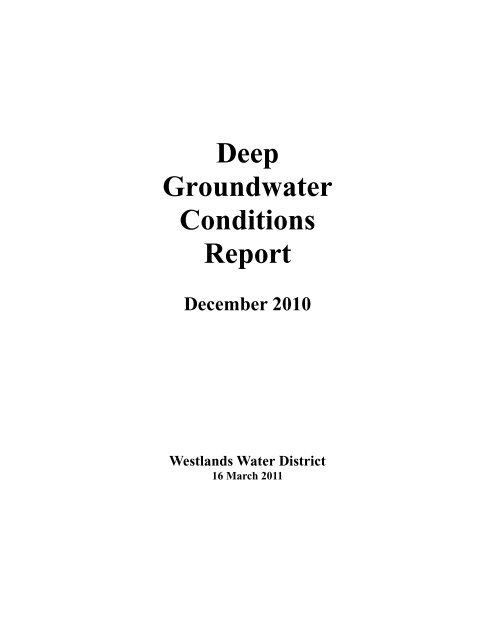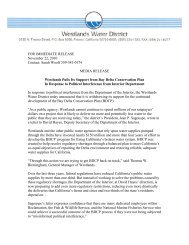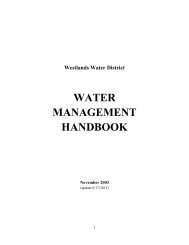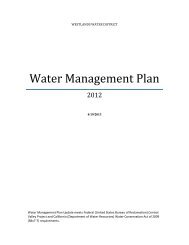Deep Groundwater Conditions Report - Westlands Water District
Deep Groundwater Conditions Report - Westlands Water District
Deep Groundwater Conditions Report - Westlands Water District
You also want an ePaper? Increase the reach of your titles
YUMPU automatically turns print PDFs into web optimized ePapers that Google loves.
Figure 1: A generalized Hydro-geological Cross Section of the <strong>District</strong>.3
Figure 2: Elevation of the Base of the Corcoran Clay (USGS Lines of Equal Elevation)4
Figure 3: The Sub-Corcoran <strong>Groundwater</strong>, Electrical Conductivity (dS/m), December 2010.5
Figure 4: The elevation of the Base of Fresh <strong>Groundwater</strong> (USGS Lines of Equal Elevation).6
<strong>Groundwater</strong> Monitoring ProgramCVP Project water and other surface water supplies are carefully allocated and all deliveriesare metered resulting in accurate water use data to manage the supplies and determine water deliverycosts. Surface water quality is monitored by state and federal agencies.<strong>Groundwater</strong> measurements and quality testing have proved useful to water users in helpingthem manage water supplies, facilitate accurate irrigation-scheduling, monitor pump efficiency andparticipate in <strong>District</strong> groundwater programs. It also enables the <strong>District</strong> to better monitorgroundwater supplies, calculate drought impacts, and determine long-term water needs.<strong>Groundwater</strong> monitoring is an essential part of managing any conjunctive use program. Thisinformation is vital to determine the affect of groundwater pumping on the aquifer, aquifer waterquality, pumping costs, and subsidence. Without effective monitoring, the short and long-termimpacts of conjunctive use cannot be determined.Annually, <strong>District</strong> wells are monitored by sounding each well while in a static condition fordepth or measuring the electrical conductivity of the water while the pump is operating. Resultsfrom the annual survey are stored in a <strong>Groundwater</strong> database and used to formulate <strong>District</strong> reportsand maps. The survey information enables the <strong>District</strong> to monitor groundwater trends, providereports to water users, estimate <strong>District</strong>-wide pumped groundwater quantities, and calculate seasonalapplication efficiency more accurately.Many of the <strong>District</strong> water users participated in the Canal Integration Program (CIP) and the<strong>District</strong> <strong>Groundwater</strong> Integration Program (DIP) during the 1990-1994, which allowed groundwaterto be pumped into the SLC and into the <strong>District</strong>’s distribution system. The water users receivedsurface water credits for the volume of groundwater pumped into the system, which then used tomeet their crop demand schedule. However, in 1995, the California Department of <strong>Water</strong> Resources(DWR) suspended the discharge of groundwater into the SLC, due to concerns that groundwatercould degrade the water quality. The DIP program has continued throughout this period except inyears when the <strong>District</strong> received full water supply. Briefly, in 2008, DWR allowed the <strong>District</strong> topump groundwater into the SLC for the period June through September because of restrictedpumping from the Delta.7
The reduction of CVP water and other surface water supplies has resulted in the constructionof many new wells, to obtain additional water to make up for the shortfall in surface irrigation water.During 1990-1999, two hundred ninety-two wells were constructed within the <strong>District</strong>, and from2000 to present an additional 229 wells were constructed, with 147 3 of these wells constructed in thelast three years.In December 2010, <strong>District</strong> staff conducted the annual <strong>Deep</strong> <strong>Groundwater</strong> Survey. The totalnumber of operational wells within the <strong>District</strong> was 641 4 with 93.3% having meters, 124 nonoperationalwells with 31.5% having meters and 232 abandoned wells. Additionally, the <strong>District</strong>monitors eighty-four wells outside its boundaries; 52 operational wells with 78.9% having meters; 9non-operational wells with no meters and 23 abandoned wells. The majority (90%) of non-<strong>District</strong>wells are located in the Five-Points area.3This number does not include three wells found being drilled; three wells found already drilled and two wells witha Well Completion <strong>Report</strong>s (WCR) received but not located.4This number does not include one well undergoing overhaul, one well with stolen wire and five new wells withoutequipment installed.8
General <strong>Conditions</strong>Prior to the delivery of CVP water into the <strong>District</strong>, the annual groundwater pumping rangedfrom 800,000 to 1,000,000 acre-feet (AF) during the period of 1950-1968. The majority of thispumping was from the aquifer below the Corcoran Clay causing the sub-Corcoran piezometricgroundwater surface to reach the lowest recorded average elevation of 156 feet below mean sea levelin 1967. The USGS calculated that the large quantity of groundwater pumped prior to delivery ofCVP water compacted water bearing sediments and causing land subsidence ranging from one totwenty-four feet between 1926 and 1972.After CVP water deliveries began in 1968, the groundwater surface rose steadily untilreaching 89 feet above mean sea level in 1987, the highest average elevation on record dating back tothe early 1940’s. The only exception during this period was in 1977 when a drought and drasticreduction of CVP deliveries resulted in groundwater pumping of approximately 472,000 AF andaccompanying drop in the groundwater surface elevation of approximately 97 feet.During the early 1990’s, groundwater pumping increased due to reduced CVP water suppliescaused by drought and regulatory actions related to the Central Valley Project Improvement Act, theEndangered Species Act, and Bay/Delta water quality requirements. <strong>Groundwater</strong> pumping reachedan estimated 600,000 AF annually during 1991 and 1992 when the <strong>District</strong> received only 25 percentof its contractual entitlement of CVP water. This increased pumping caused the groundwater surfaceto decline to 62 feet below mean sea level, the lowest elevation since 1977. Because of thegroundwater pumping, increased subsidence occurred in the <strong>District</strong> and other areas in the westernCentral Valley. The Department of <strong>Water</strong> Resources estimated the amount of subsidence since 1983to be almost two feet in some areas of the <strong>District</strong> with the most of that subsidence occurring since1989.Current <strong>Conditions</strong>Over the last five years, 2006 to 2010, CVP allocations averaged 49% (525,730 acre-feet) 5total groundwater pumped was 1,405,000 acre-feet and the groundwater surface elevation decreased47 feet. In 2010 the CVP allocation was 45% (517,500 acre-feet) and accompanying decrease ingroundwater pumped (140,000 acre-feet), the groundwater surface increase 40 feet to an averageelevation of 9 feet above mean sea level.5Average Net CVP (adjusted CVP Allocation for carry over and rescheduled losses).9
<strong>Groundwater</strong> elevations and the estimated amount of groundwater pumped from last sixtyyears are shown in Table 2. This table shows the average elevation of the groundwater in the lowerwater bearing zone and the change in elevation for each year.ElevationChangeFTElevationChangeFTCrop 6 Pumped ElevationCrop Pumped ElevationYear AF FTYear AF FT1951 840,000 -9 1981 99,000 11 71952 1,000,000 1982 105,000 32 211953 952,000 -35 1983 31,000 56 241954 852,000 1984 73,000 61 51955 904,000 -52 1985 228,000 63 21956 964,000 -65 -13 1986 145,000 71 81957 928,000 -56 9 1987 159,000 89 181958 884,000 -29 27 1988 160,000 64 -251959 912,000 -77 -48 1989 175,000 63 -11960 872,000 -81 -4 1990 300,000 9 -541961 824,000 -96 -15 1991 600,000 -32 -411962 920,000 1992 600,000 -62 -301963 883,000 1993 225,000 1 631964 913,000 1994 325,000 -51 -521965 822,000 1995 150,000 27 781966 924,000 -134 1996 50,000 49 221967 875,000 -156 -22 1997 30,000 63 141968 596,000 -135 21 1998 15,000 63 01969 592,000 -120 15 1999 20,000 65 21970 460,000 -100 20 2000 225,000 43 -221971 377,000 -93 7 2001 215,000 25 -181972 -54 39 2002 205,000 22 -31973 -37 17 2003 160,000 30 81974 96,000 -22 15 2004 210,000 24 -61975 111,000 -11 11 2005 75,000 56 321976 97,000 -2 9 2006 15,000 77 211977 472,000 -99 -97 2007 310,000 35 -421978 159,000 -4 95 2008 460,000 -11 -461979 140,000 -13 -9 2009 480,000 -31 -201980 106,000 4 17 2010 140,000 9 40Table 2: 60-years of estimated groundwater pumpage. 76Crop year is from 1 October (previous year) to 30 September (current year) for the year in question.7Data compiled from PG&E power records by USBR through 1971 and USGS 1974-1987, <strong>District</strong> estimates 1988-present. Elevation data for 1943-1961 and 1977 from Bill Coor, USBR (requested by the <strong>District</strong> and received on4/20/1978) and elevation for 1966-1976 from Plate 5 of “Project Effects on Sub-Corcoran <strong>Water</strong> Layers” (April 1977).10
Figure 5 shows in graphical format the historical average elevation of the Sub-Corcoranpiezometric groundwater surface and the estimated amount of groundwater pumped in the <strong>District</strong>.Figures 6 and 7 shows the depth to the piezometric groundwater surface in the lower water-bearingzone during December 1994 and during December 2010, respectively. The Figure 8 drawing showsthe change in depth to the piezometric groundwater surface from December 1994 to December 2010.In addition to monitoring the water levels of wells pumping from the lower aquifer, the wellspumping from the upper aquifer are also monitored. The majority of the wells pumping from theupper aquifer had groundwater surface levels 100 to 300 feet below ground surface during December2010 as shown in Figure 9.Average Elevation of Piezometric <strong>Groundwater</strong> Surface in Feet150100500-50-100-150-200ElevationPumpage700,000600,000500,000400,000300,000200,000100,000<strong>Groundwater</strong> Pumpage in Acre/Feet-2501981198319851987198919911993199519971999200120032005200720090YearFigure 5: The historical 30-year Average Elevation of Sub-Corcoran Piezometric <strong>Groundwater</strong> Surface and<strong>Groundwater</strong> Pumpage.11
Figure 6: Depth to Sub-Corcoran Piezometric <strong>Groundwater</strong> Surface, December 1994.12
Figure 7: Depth to Sub-Corcoran Piezometric <strong>Groundwater</strong> Surface December 2010.13
Figure 8: 1994 – 2010 Change in Depth to the Sub-Corcoran Piezometric <strong>Groundwater</strong> Surface.14
Figure 9: Depth to <strong>Groundwater</strong> in the Upper Zone, December 2010.15
Safe YieldSafe yield or current perennial yield is the amount of groundwater that can be extractedwithout lowering groundwater levels over the long term. Current perennial yield can be determinedby plotting the amount of groundwater pumped in one year versus the average change in groundwaterlevel in the basin for that year. Data for 1976 to present were plotted and a “best fit” was drawn.The intersection of the best fit with the line showing zero groundwater level change as shown inFigure 10 indicates the current perennial yield of groundwater to be approximately 200,000 AF.150ChangeLinear (Change)100Change in <strong>Groundwater</strong> Elevation in Feet500(50)(100)(150)0 100,000 200,000 300,000 400,000 500,000 600,000 700,000Pumpage in Acre/Feet 1976 through 2010Figure 10: Change in <strong>Groundwater</strong> Elevation versus Pumping.16





